Influence of nisubstitution for Mn on the structure and ionic conductivity of LiNixMn2-xO4 spinel materials prepaired by the sol-gel method
Electrode materials LiNixMn2-xO4 with (x = 0; 0.05; 0.1; 0.2) were synthesized
by the sol-gel method from lithium acetate, manganese acetate and nikel acetate. The FESEMs show that the morphology of the material changes when the anealing temperature
and the proportion replacement of Mn with Ni changes. XRDs confirmed that the samples
have LiNixMn2-xO4 spinel structures without any contaminants. Lattice constants of the
material increase with annealing temperature and decrease when Ni ratio substitution
increases. As the proportion replacement of Ni increases, the particle size of the LiNixMn2-
xO4 samples decreases while the grain boundary changes from the rounded form at x = 0
to the form of sharp edges at x = 0.1 and 0.2. These results show the effect of nickel doping
on crystal stability. The studies of impedance spectroscopy were applied to the bulk
materials showing the Li+ ion conductivity of the material. The results indicate that
substituting Ni for Mn improved the conductivity of the materials tp = 19,773 × 10-5
S.cm-1 with x = 0.1, anealing temperature at 700 °C compared to tp = 0.111 × 10-5 S.cm-
1 of the samples with x = 0.
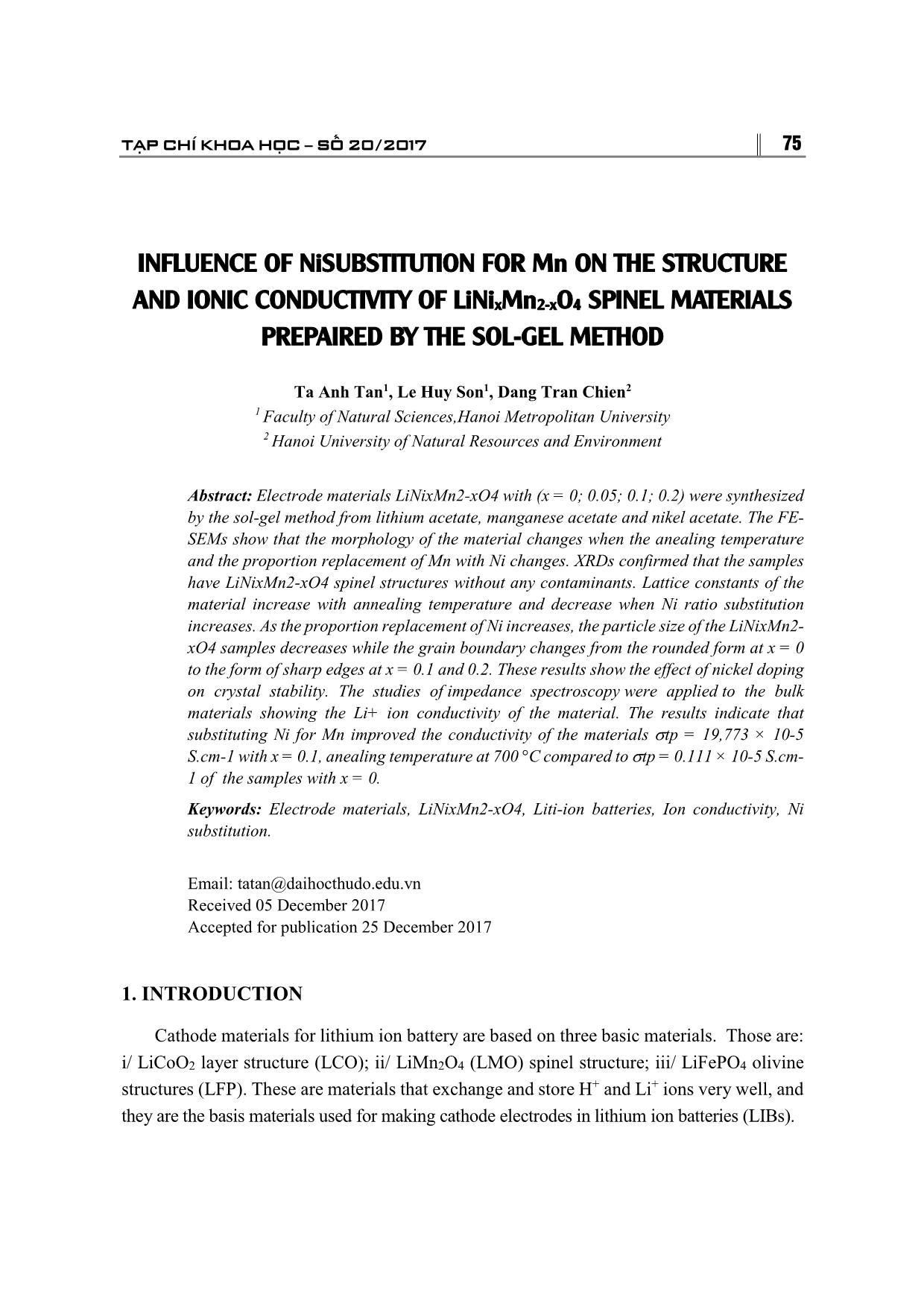
Trang 1
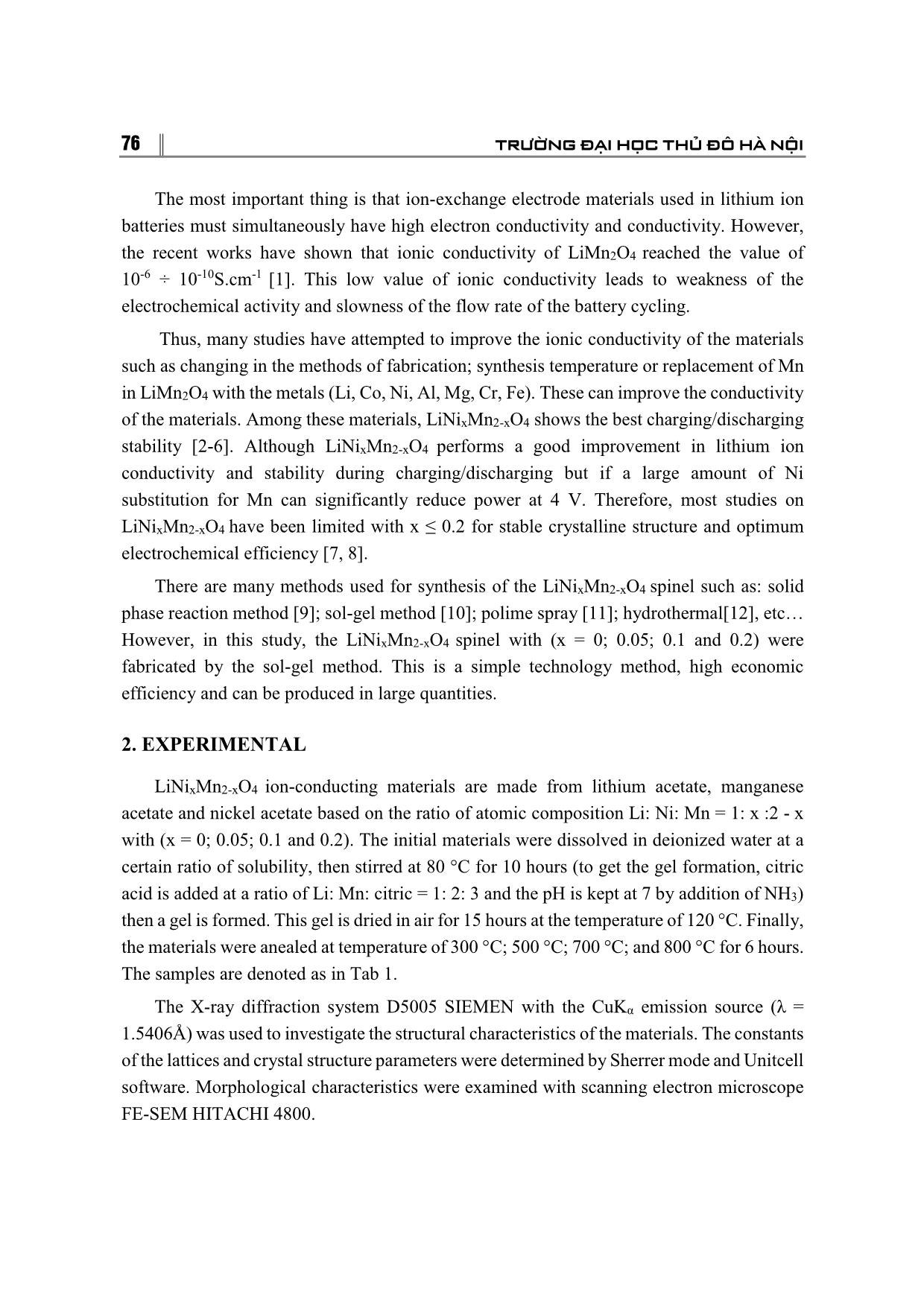
Trang 2

Trang 3
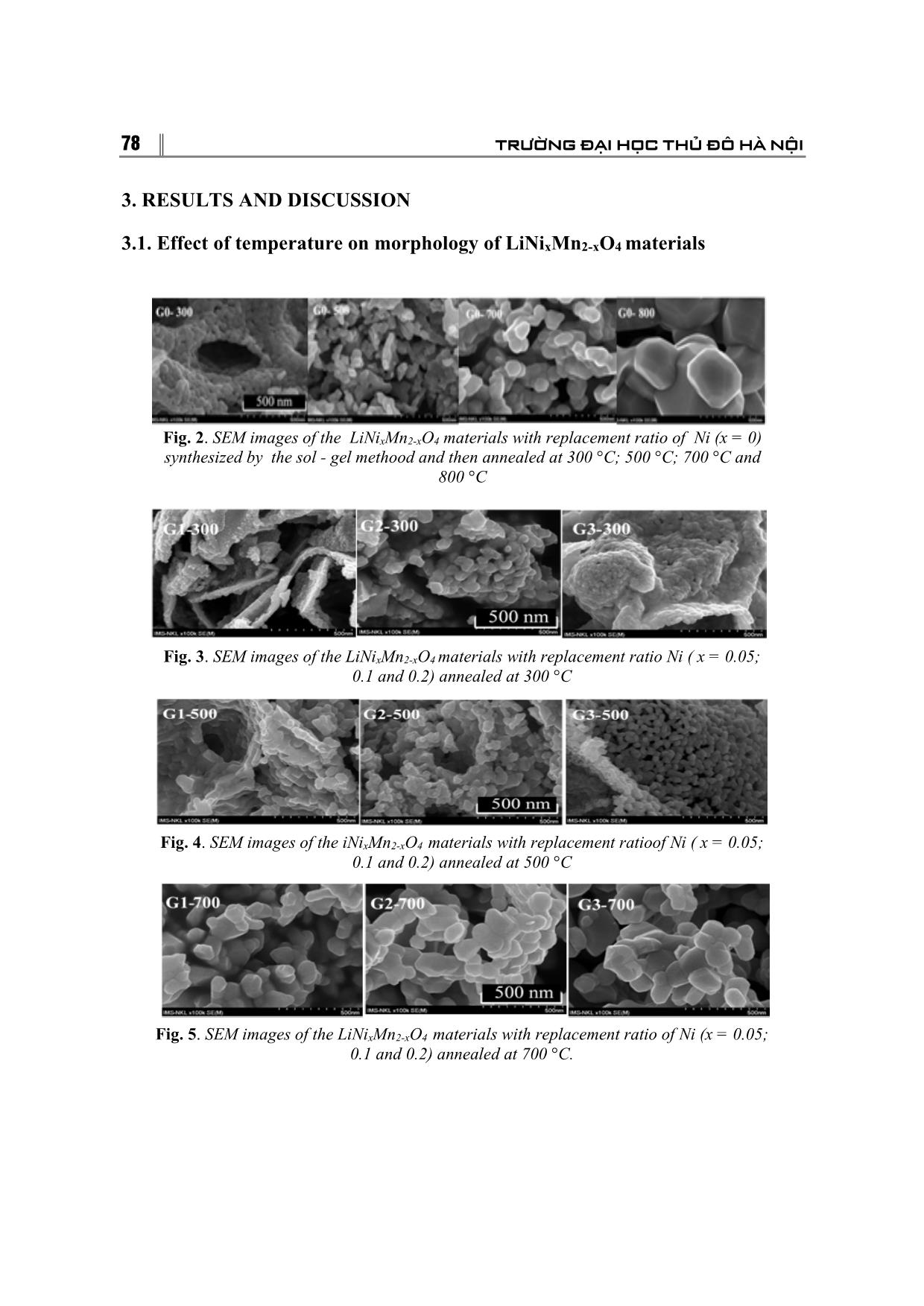
Trang 4
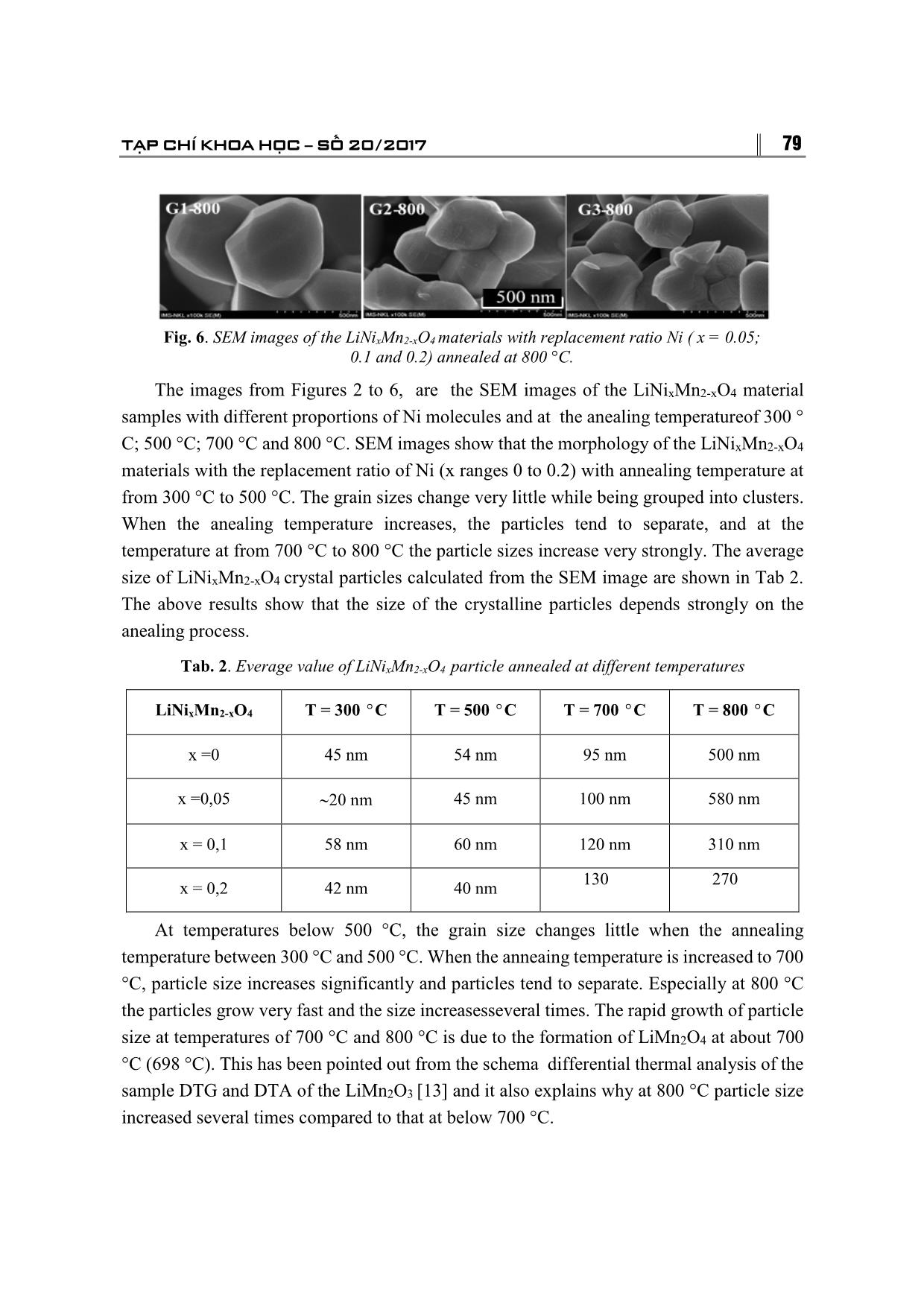
Trang 5
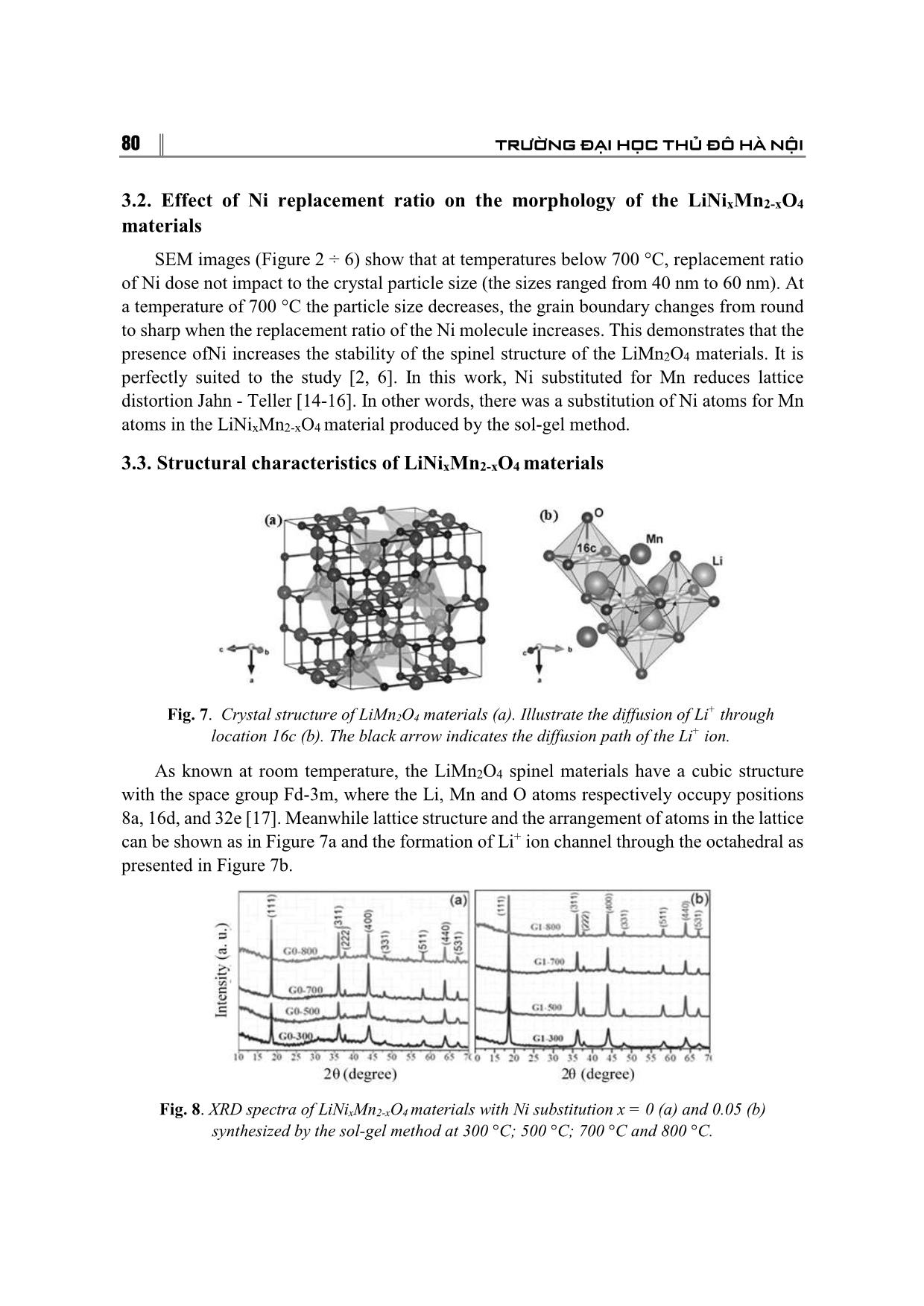
Trang 6
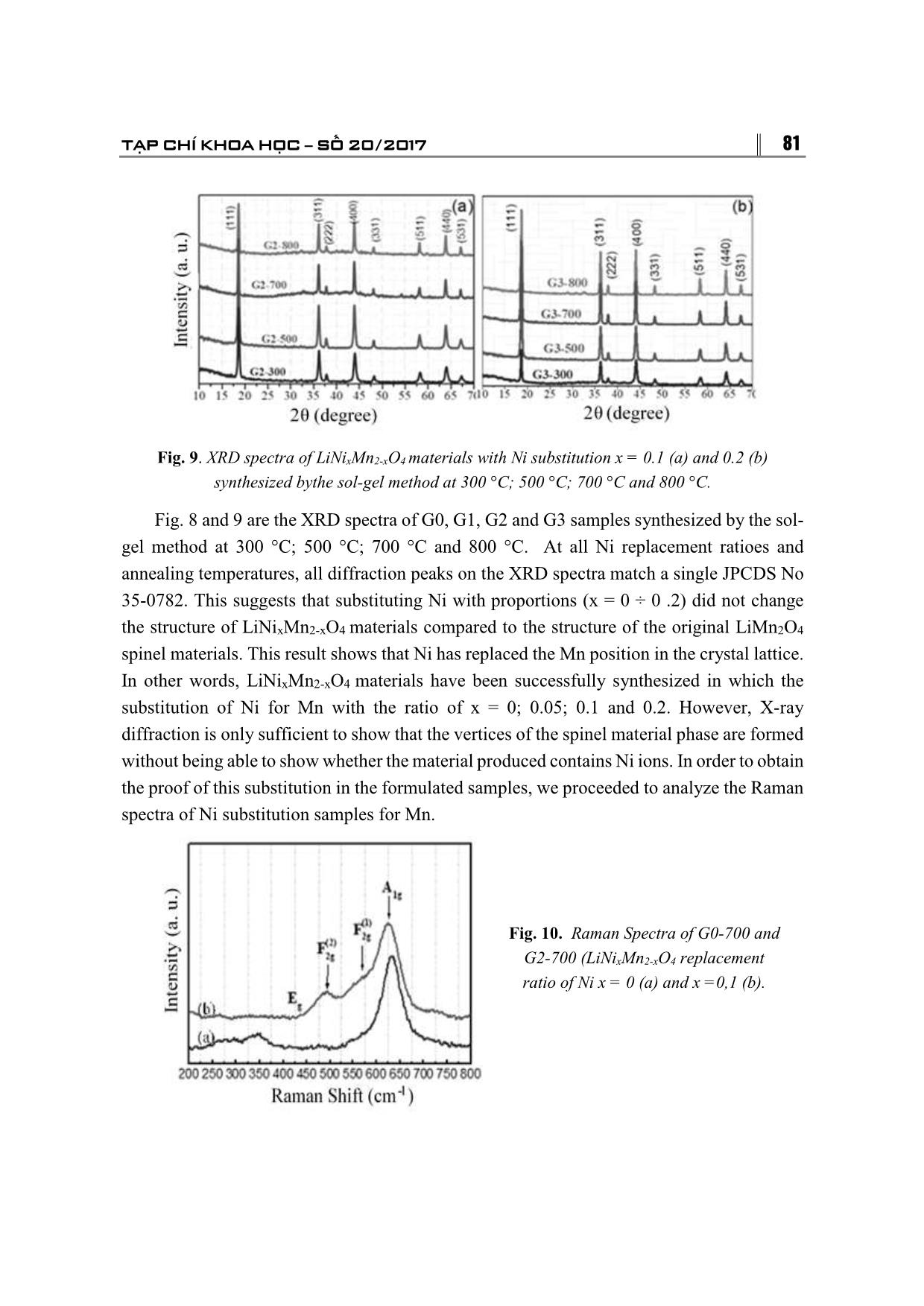
Trang 7
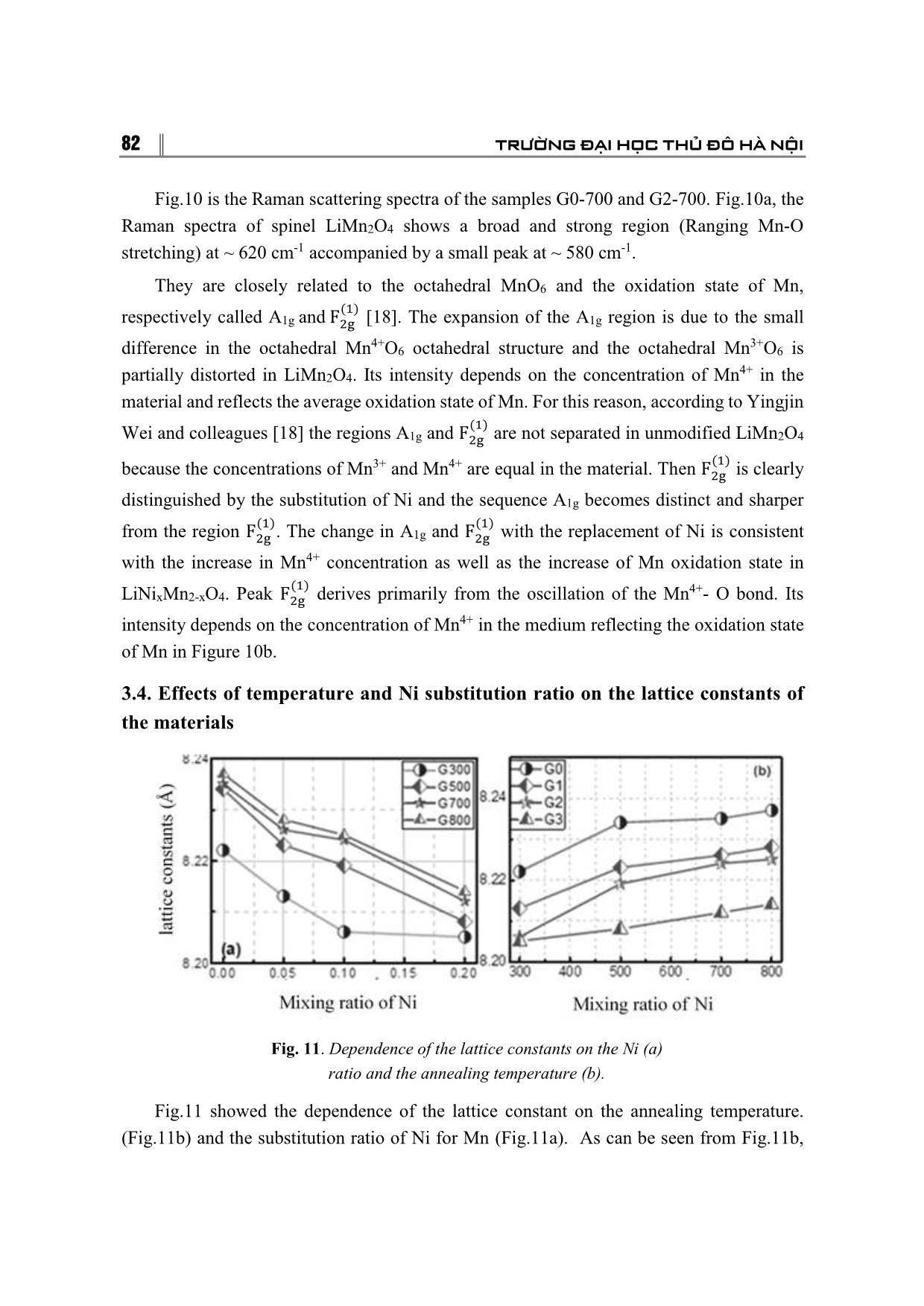
Trang 8
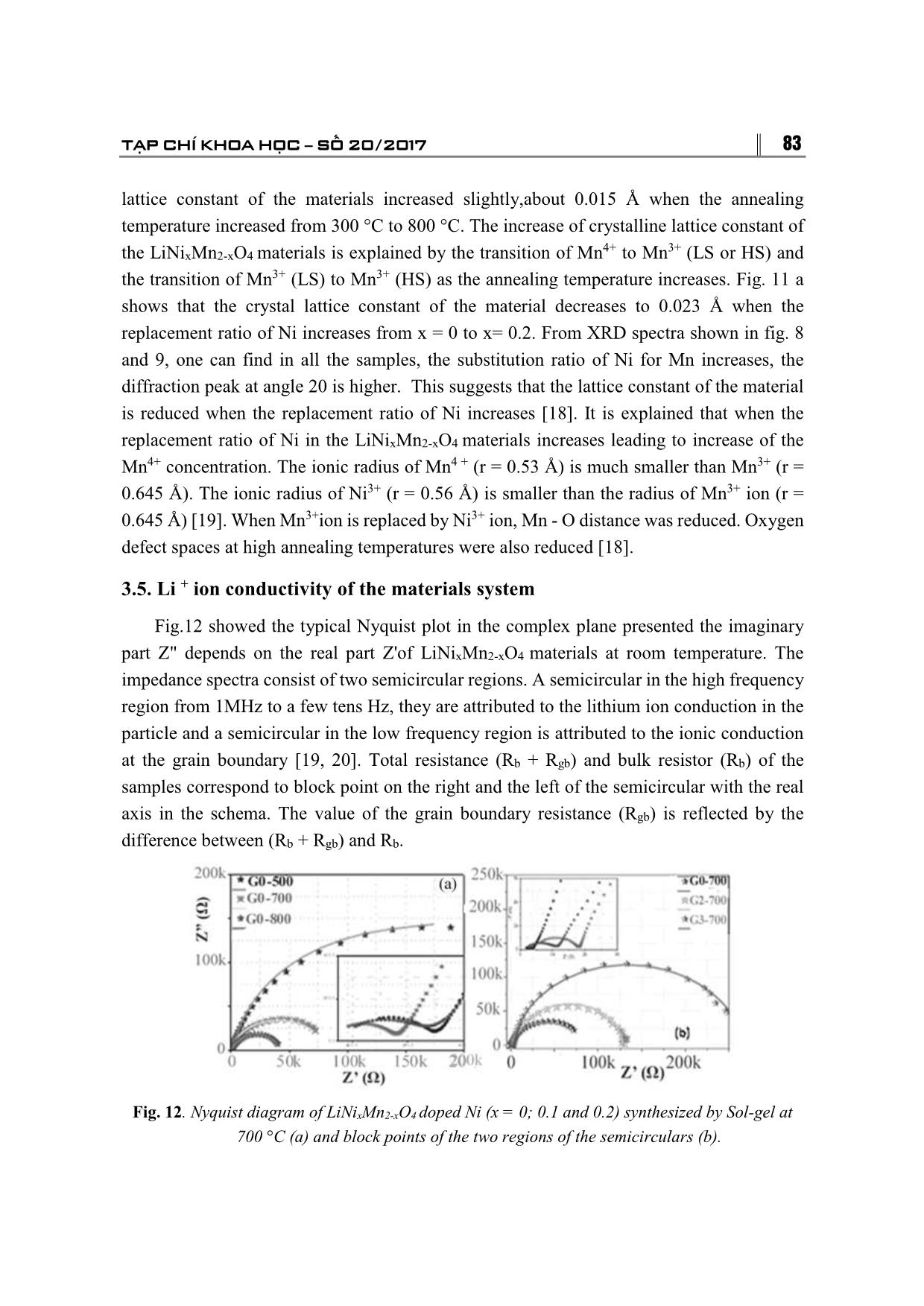
Trang 9
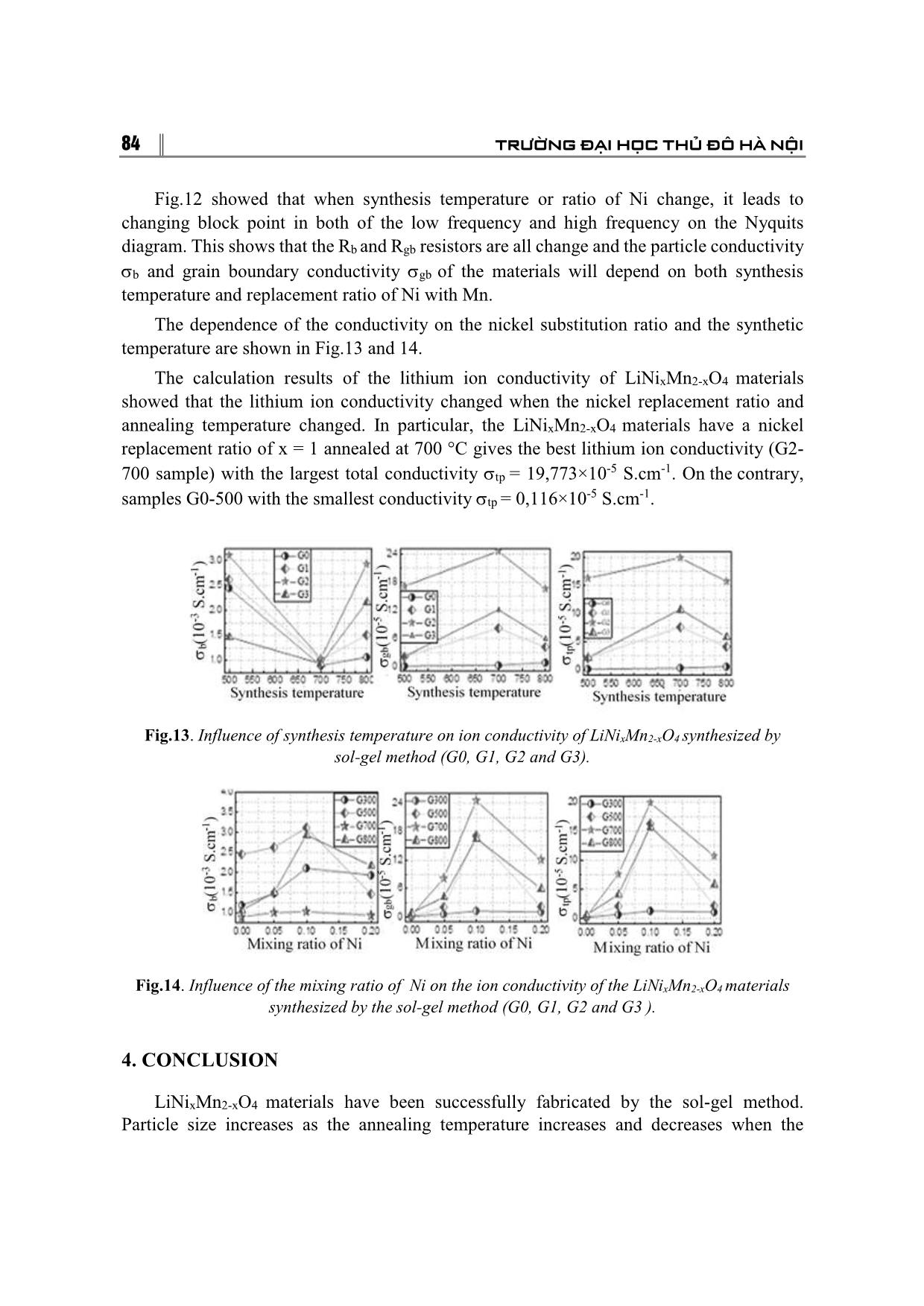
Trang 10
Tải về để xem bản đầy đủ
Tóm tắt nội dung tài liệu: Influence of nisubstitution for Mn on the structure and ionic conductivity of LiNixMn2-xO4 spinel materials prepaired by the sol-gel method
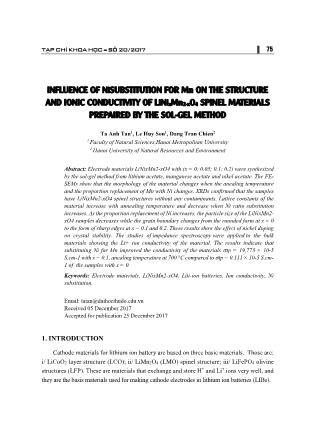
TẠP CHÍ KHOA HỌC SỐ 20/2017 75 INFLUENCE OF NiSUBSTITUTION FOR Mn ON THE STRUCTURE AND IONIC CONDUCTIVITY OF LiNixMn2-xO4 SPINEL MATERIALS PREPAIRED BY THE SOL-GEL METHOD Ta Anh Tan1, Le Huy Son1, Dang Tran Chien2 1 Faculty of Natural Sciences,Hanoi Metropolitan University 2 Hanoi University of Natural Resources and Environment Abstract: Electrode materials LiNixMn2-xO4 with (x = 0; 0.05; 0.1; 0.2) were synthesized by the sol-gel method from lithium acetate, manganese acetate and nikel acetate. The FE- SEMs show that the morphology of the material changes when the anealing temperature and the proportion replacement of Mn with Ni changes. XRDs confirmed that the samples have LiNixMn2-xO4 spinel structures without any contaminants. Lattice constants of the material increase with annealing temperature and decrease when Ni ratio substitution increases. As the proportion replacement of Ni increases, the particle size of the LiNixMn2- xO4 samples decreases while the grain boundary changes from the rounded form at x = 0 to the form of sharp edges at x = 0.1 and 0.2. These results show the effect of nickel doping on crystal stability. The studies of impedance spectroscopy were applied to the bulk materials showing the Li+ ion conductivity of the material. The results indicate that substituting Ni for Mn improved the conductivity of the materials tp = 19,773 × 10-5 S.cm-1 with x = 0.1, anealing temperature at 700 °C compared to tp = 0.111 × 10-5 S.cm- 1 of the samples with x = 0. Keywords: Electrode materials, LiNixMn2-xO4, Liti-ion batteries, Ion conductivity, Ni substitution. Email: tatan@daihocthudo.edu.vn Received 05 December 2017 Accepted for publication 25 December 2017 1. INTRODUCTION Cathode materials for lithium ion battery are based on three basic materials. Those are: i/ LiCoO2 layer structure (LCO); ii/ LiMn2O4 (LMO) spinel structure; iii/ LiFePO4 olivine structures (LFP). These are materials that exchange and store H+ and Li+ ions very well, and they are the basis materials used for making cathode electrodes in lithium ion batteries (LIBs). 76 TRƯỜNG ĐẠI HỌC THỦ ĐÔ HÀ NỘI The most important thing is that ion-exchange electrode materials used in lithium ion batteries must simultaneously have high electron conductivity and conductivity. However, the recent works have shown that ionic conductivity of LiMn2O4 reached the value of 10-6 ÷ 10-10S.cm-1 [1]. This low value of ionic conductivity leads to weakness of the electrochemical activity and slowness of the flow rate of the battery cycling. Thus, many studies have attempted to improve the ionic conductivity of the materials such as changing in the methods of fabrication; synthesis temperature or replacement of Mn in LiMn2O4 with the metals (Li, Co, Ni, Al, Mg, Cr, Fe). These can improve the conductivity of the materials. Among these materials, LiNixMn2-xO4 shows the best charging/discharging stability [2-6]. Although LiNixMn2-xO4 performs a good improvement in lithium ion conductivity and stability during charging/discharging but if a large amount of Ni substitution for Mn can significantly reduce power at 4 V. Therefore, most studies on LiNixMn2-xO4 have been limited with x ≤ 0.2 for stable crystalline structure and optimum electrochemical efficiency [7, 8]. There are many methods used for synthesis of the LiNixMn2-xO4 spinel such as: solid phase reaction method [9]; sol-gel method [10]; polime spray [11]; hydrothermal[12], etc However, in this study, the LiNixMn2-xO4 spinel with (x = 0; 0.05; 0.1 and 0.2) were fabricated by the sol-gel method. This is a simple technology method, high economic efficiency and can be produced in large quantities. 2. EXPERIMENTAL LiNixMn2-xO4 ion-conducting materials are made from lithium acetate, manganese acetate and nickel acetate based on the ratio of atomic composition Li: Ni: Mn = 1: x :2 - x with (x = 0; 0.05; 0.1 and 0.2). The initial materials were dissolved in deionized water at a certain ratio of solubility, then stirred at 80 °C for 10 hours (to get the gel formation, citric acid is added at a ratio of Li: Mn: citric = 1: 2: 3 and the pH is kept at 7 by addition of NH3) then a gel is formed. This gel is dried in air for 15 hours at the temperature of 120 °C. Finally, the materials were anealed at temperature of 300 °C; 500 °C; 700 °C; and 800 °C for 6 hours. The samples are denoted as in Tab 1. The X-ray diffraction system D5005 SIEMEN with the CuKα emission source (λ = 1.5406Å) was used to investigate the structural characteristics of the materials. The constants of the lattices and crystal structure parameters were determined by Sherrer mode and Unitcell software. Morphological characteristics were examined with scanning electron microscope FE-SEM HITACHI 4800. TẠP CHÍ KHOA HỌC SỐ 20/2017 77 Tab. 1. Symbol of LiNixMn2-xO4 with Ni substitution x = 0, 0.05, 0.1 and 0.2 at anealing temperature of 300 °C, 500 °C, 700 °C and 800 °C. Sample symbol LiNixMn2-xO4 Temperature (C) G0-300 x = 0 300 G0-500 x = 0 500 G0-700 x = 0 700 G0-800 x = 0 800 G1-300 x = 0,05 300 G1-500 x = 0,05 500 G1-700 x = 0,05 700 G1-800 x = 0,05 800 G2-300 x = 0,1 300 G2-500 x = 0,1 500 G2-700 x = 0,1 700 G2-800 x = 0,1 800 G3-300 x = 0,2 300 G3-500 x = 0,2 500 G3-700 x = 0,2 700 G3-800 x = 0,2 800 Impedance spectra were applied to investigate the ionic conductivity of the samples via electrochemical systems Autolab PSGTAT 100. The ionic conductivity of the material is determined by the method of matching the experimental results using the NOVA software. The samples were prepared by pressing a 1cm- diameter pellet with a pressure of 40 MPa/cm2. A Au electrode with a di ... s 8a, 16d, and 32e [17]. Meanwhile lattice structure and the arrangement of atoms in the lattice can be shown as in Figure 7a and the formation of Li+ ion channel through the octahedral as presented in Figure 7b. Fig. 8. XRD spectra of LiNixMn2-xO4 materials with Ni substitution x = 0 (a) and 0.05 (b) synthesized by the sol-gel method at 300 °C; 500 °C; 700 °C and 800 °C. Fig. 7. Crystal structure of LiMn2O4 materials (a). Illustrate the diffusion of Li+ through location 16c (b). The black arrow indicates the diffusion path of the Li+ ion. TẠP CHÍ KHOA HỌC SỐ 20/2017 81 Fig. 9. XRD spectra of LiNixMn2-xO4 materials with Ni substitution x = 0.1 (a) and 0.2 (b) synthesized bythe sol-gel method at 300 °C; 500 °C; 700 °C and 800 °C. Fig. 8 and 9 are the XRD spectra of G0, G1, G2 and G3 samples synthesized by the sol- gel method at 300 °C; 500 °C; 700 °C and 800 °C. At all Ni replacement ratioes and annealing temperatures, all diffraction peaks on the XRD spectra match a single JPCDS No 35-0782. This suggests that substituting Ni with proportions (x = 0 ÷ 0 .2) did not change the structure of LiNixMn2-xO4 materials compared to the structure of the original LiMn2O4 spinel materials. This result shows that Ni has replaced the Mn position in the crystal lattice. In other words, LiNixMn2-xO4 materials have been successfully synthesized in which the substitution of Ni for Mn with the ratio of x = 0; 0.05; 0.1 and 0.2. However, X-ray diffraction is only sufficient to show that the vertices of the spinel material phase are formed without being able to show whether the material produced contains Ni ions. In order to obtain the proof of this substitution in the formulated samples, we proceeded to analyze the Raman spectra of Ni substitution samples for Mn. Fig. 10. Raman Spectra of G0-700 and G2-700 (LiNixMn2-xO4 replacement ratio of Ni x = 0 (a) and x =0,1 (b). 82 TRƯỜNG ĐẠI HỌC THỦ ĐÔ HÀ NỘI Fig.10 is the Raman scattering spectra of the samples G0-700 and G2-700. Fig.10a, the Raman spectra of spinel LiMn2O4 shows a broad and strong region (Ranging Mn-O stretching) at ~ 620 cm-1 accompanied by a small peak at ~ 580 cm-1. They are closely related to the octahedral MnO6 and the oxidation state of Mn, respectively called A1g and F�� (�) [18]. The expansion of the A1g region is due to the small difference in the octahedral Mn4+O6 octahedral structure and the octahedral Mn3+O6 is partially distorted in LiMn2O4. Its intensity depends on the concentration of Mn4+ in the material and reflects the average oxidation state of Mn. For this reason, according to Yingjin Wei and colleagues [18] the regions A1g and F�� (�) are not separated in unmodified LiMn2O4 because the concentrations of Mn3+ and Mn4+ are equal in the material. Then F�� (�) is clearly distinguished by the substitution of Ni and the sequence A1g becomes distinct and sharper from the region F�� (�) . The change in A1g and F�� (�) with the replacement of Ni is consistent with the increase in Mn4+ concentration as well as the increase of Mn oxidation state in LiNixMn2-xO4. Peak F�� (�) derives primarily from the oscillation of the Mn4+- O bond. Its intensity depends on the concentration of Mn4+ in the medium reflecting the oxidation state of Mn in Figure 10b. 3.4. Effects of temperature and Ni substitution ratio on the lattice constants of the materials Fig. 11. Dependence of the lattice constants on the Ni (a) ratio and the annealing temperature (b). Fig.11 showed the dependence of the lattice constant on the annealing temperature. (Fig.11b) and the substitution ratio of Ni for Mn (Fig.11a). As can be seen from Fig.11b, TẠP CHÍ KHOA HỌC SỐ 20/2017 83 lattice constant of the materials increased slightly,about 0.015 Å when the annealing temperature increased from 300 °C to 800 °C. The increase of crystalline lattice constant of the LiNixMn2-xO4 materials is explained by the transition of Mn4+ to Mn3+ (LS or HS) and the transition of Mn3+ (LS) to Mn3+ (HS) as the annealing temperature increases. Fig. 11 a shows that the crystal lattice constant of the material decreases to 0.023 Å when the replacement ratio of Ni increases from x = 0 to x= 0.2. From XRD spectra shown in fig. 8 and 9, one can find in all the samples, the substitution ratio of Ni for Mn increases, the diffraction peak at angle 20 is higher. This suggests that the lattice constant of the material is reduced when the replacement ratio of Ni increases [18]. It is explained that when the replacement ratio of Ni in the LiNixMn2-xO4 materials increases leading to increase of the Mn4+ concentration. The ionic radius of Mn4 + (r = 0.53 Å) is much smaller than Mn3+ (r = 0.645 Å). The ionic radius of Ni3+ (r = 0.56 Å) is smaller than the radius of Mn3+ ion (r = 0.645 Å) [19]. When Mn3+ion is replaced by Ni3+ ion, Mn - O distance was reduced. Oxygen defect spaces at high annealing temperatures were also reduced [18]. 3.5. Li + ion conductivity of the materials system Fig.12 showed the typical Nyquist plot in the complex plane presented the imaginary part Z" depends on the real part Z'of LiNixMn2-xO4 materials at room temperature. The impedance spectra consist of two semicircular regions. A semicircular in the high frequency region from 1MHz to a few tens Hz, they are attributed to the lithium ion conduction in the particle and a semicircular in the low frequency region is attributed to the ionic conduction at the grain boundary [19, 20]. Total resistance (Rb + Rgb) and bulk resistor (Rb) of the samples correspond to block point on the right and the left of the semicircular with the real axis in the schema. The value of the grain boundary resistance (Rgb) is reflected by the difference between (Rb + Rgb) and Rb. Fig. 12. Nyquist diagram of LiNixMn2-xO4 doped Ni (x = 0; 0.1 and 0.2) synthesized by Sol-gel at 700 °C (a) and block points of the two regions of the semicirculars (b). 84 TRƯỜNG ĐẠI HỌC THỦ ĐÔ HÀ NỘI Fig.12 showed that when synthesis temperature or ratio of Ni change, it leads to changing block point in both of the low frequency and high frequency on the Nyquits diagram. This shows that the Rb and Rgb resistors are all change and the particle conductivity b and grain boundary conductivity gb of the materials will depend on both synthesis temperature and replacement ratio of Ni with Mn. The dependence of the conductivity on the nickel substitution ratio and the synthetic temperature are shown in Fig.13 and 14. The calculation results of the lithium ion conductivity of LiNixMn2-xO4 materials showed that the lithium ion conductivity changed when the nickel replacement ratio and annealing temperature changed. In particular, the LiNixMn2-xO4 materials have a nickel replacement ratio of x = 1 annealed at 700 °C gives the best lithium ion conductivity (G2- 700 sample) with the largest total conductivity tp = 19,773×10-5 S.cm-1. On the contrary, samples G0-500 with the smallest conductivity tp = 0,116×10-5 S.cm-1. Fig.13. Influence of synthesis temperature on ion conductivity of LiNixMn2-xO4 synthesized by sol-gel method (G0, G1, G2 and G3). Fig.14. Influence of the mixing ratio of Ni on the ion conductivity of the LiNixMn2-xO4 materials synthesized by the sol-gel method (G0, G1, G2 and G3 ). 4. CONCLUSION LiNixMn2-xO4 materials have been successfully fabricated by the sol-gel method. Particle size increases as the annealing temperature increases and decreases when the TẠP CHÍ KHOA HỌC SỐ 20/2017 85 substitution ratio of Ni substituted for Mn increases. The surface of the LiNixMn2- xO4particles from the rounded form turns sharp when the ratio of Ni increases. Particle sizeschange in the range of 30 nm to 500 nm. The lattice constant (a) of the materials increases with increase of the annealing temperature and decreases with the increase of the ratio of Ni. The values are between 8.21 and 8.24 Å. The ionic conductivity of the materials is strongly dependent on the substitution ratio of Ni molecules for Mn.The sample has the best conductivity at the ratioof x = 0.1; T = 700 °C and gives the maximum ionic conductivity tp = 19,773.10-5 S.cm-1. REFERENCES 1. Wu.M, B.Xu, and .C.Ouyang (2016), Physicsofelectronandlithium-iontransportin electrodematerialsforLi-ionbatteries. Chin.Phys.B, 25(1): p.018206 2. Xin.G, et al. (2012), Synthesis of Spinel LiNixMn2-xO4 (x=0, 0.1, 0.16) and Their High Rate Charge-Discharge Performances Int. J. Electrochem. Sci, 7: pp.2504 – 2512 3. Kebede.M.A, et al (2013), Synthesis and Electrochemical Properties of Ni Doped Spinel LiNixMn2-xO4 (0 ≤ x ≤ 0.5) Cathode Materials for Li-Ion Battery. ECS Transactions, 50(40): pp.1-14 4. Wang.F.X , et al (2013), Spinel LiNixMn2−xO4 as cathode material for aqueous rechargeable lithium batteries. Electrochimica Acta, 93: pp.301-306. 5. Adnan Hafez.M, K.Mohammad Bashir, and K. Ahmed Khaled (2016), Studying Structural and Optical Properties of Thin Films LiNixMn2-xO4 (x = 0, 0.4, 0.5, 0.6) Prepared by Sol-Gel Method American Journal of Nanosciences, 2(4): pp.46-50. 6. Purwaningsih.D, R.Roto, and H.Sutrisno (2016), Synthesis of LiNix Mn2-xO4 by low-temperature solid-state reaction and its microstructure. IOP Conference Series: Materials Science and Engineering, 107(1): pp.012-033. 7. Guo.D, et al (2014), Facile synthesis of LiAl0.1Mn1.9O4 as cathode material for lithium ion batteries: towards rate and cycling capabilities at an elevated temperature. Electrochimica Acta, 134: pp.338-346. 8. Lee.Y-S, N.Kumada, and M.Yoshio (2001), Synthesis and characterization of lithium aluminum-doped spinel (LiAlxMn2−xO4) for lithium secondary battery. Journal of Power Sources, 96(2): pp.376-384. 9. Liu. B-S, et al (2015), Preparation of submicrocrystal LiMn2O4 used Mn3O4 as precursor and its electrochemical performance for lithium ion battery. Journal of Alloys and Compounds, 622: pp.902-907. 10. Wang.S, et al (2015), Preparation of spinel LiNi0.5Mn1.5O4 and Cr-doped LiNi0.5Mn1.5O4 cathode materials by tartaric acid assisted sol–gel method. Ceramics International, 41(1, Part B): pp.1347-1353. 11. Karthick.S.N, et al (2010), Nanocrystalline LiMn2O4 thin film cathode material prepared by polymer spray pyrolysis method for Li-ion battery. Journal of Alloys and Compounds, 489(2): pp.674-677. 86 TRƯỜNG ĐẠI HỌC THỦ ĐÔ HÀ NỘI 12. Xia.H, et al (2012), Ultrafine LiMn2O4/carbon nanotube nanocomposite with excellent rate capability and cycling stability for lithium-ion batteries. Journal of Power Sources, 212: pp.28-34. 13. Phạm Duy Long (2002), Chế tạo màng mỏng oxit kim loại chuyển tiếp (W, Mn) và nghiên cứu các tính chất điện sắc, tích trữ ion của chúng. Luận án Tiến sĩ Khoa học Vật liệu, Vien Han lam Khoa hoc va Cong nghe Viet Nam. 14. Shi.S, et al (2003), First-principles studies of cation-doped spinel LiMn2O4 for lithium ion batteries. Physical Review B, 67(11): p.115130. 15. Arroyo y de Dompablo, M.E. and J.Morales (2006), A First-Principles Investigation of the Role Played by Oxygen Deficiency in the Electrochemical Properties of LiCu0.5Mn1.5O4−δ Spinels. Journal of The Electrochemical Society, 153(11): pp.A2098-A2102. 16. Yi T-F, Y-R.Zhu, and R-S.Zhu (2008), Density functional theory study of lithium intercalation for 5 V LiNi0.5Mn1.5O4 cathode materials. Solid State Ionics, 179(38): pp.2132-2136. 17. Zhong.Q, et al (1997), Synthesis and Electrochemistry of LiNixMn2−x O4. Journal of The Electrochemical Society, 144(1): pp.205-213. 18. Wei.Y, et al (2006), Spectroscopic studies of the structural properties of Ni substituted spinel LiMn2O4. Solid State Ionics, 177(1–2): pp.29-35. 19. Bauerle. J.E (1969), Study of solid electrolyte polarization by a complex admittance method. Journal of Physics and Chemistry of Solids, 30(12): pp.2657-2670. 20. Mariusz.K.R.Marta, and R.Mieczysaw (2011), Impedance Spectroscopy Study of ElectrodeElectrolyte System in Solid Oxide Fuel Cells. Materialy Ceramiczne/Ceramic Materials, 63(1): pp.157-163. ẢNH HƯỞNG CỦA SỰ THAY THẾ MN BẰNG Ni LÊN CẤU TRÚC VÀ ĐỘ DẪN ION CỦA VẬT LIỆUSPINEL LiNixMn2-xO4 TỔNG HỢP BẰNG PHƯƠNG PHÁP SOL – GEL Tóm tắt: Vật liệu điện cực LiNixMn2-xO4 với (x = 0; 0,05; 0,1; 0,2) được tổng hợp ở bằng phương pháp sol - gel từ liti axetat, mangagan axetat và niken axetat. Ảnh FE-SEM cho thấy hình thái học của vật liệu thay đổi theo nhiệt độ tổng hợp và tỷ lệ thay thế của Ni cho Mn. Phổ XRD đã xác nhận các mẫu thu được có cấu trúc spinel của LiNixMn2-xO4 mà không có bất kỳ tạp chất nào. Hằng số mạng của hệ vật liệu tăng lên theo nhiệt độ ủ và giảm đi khi tỷ lệ thay thế Ni tăng lên. Khi hàm lượng Ni tăng lên, kích thước hạt của các mẫu LiNixMn2-xO4 giảm đi đồng thời biên hạt chuyển từ dạng tròn cạnh tại x = 0 sang dạng các hình khối sắc cạnh ở x = 0,1 và 0,2 cho thấy hiệu quả rõ rệt của việc pha tạp niken đến sự ổn định trật tự của tinh thể. Phép đo phổ tổng trở xoay chiều của vật liệu dạng khối xác định được độ dẫn ion Li+ của vật liệu. Kết quả chỉ ra rằng, thay thế Ni cho Mn cải thiện tốt độ dẫn của vật liệu, đồng thời cho thấy vật liệu có x = 0,1 và nhiệt độ tổng hợp ở 700 °C cho độ dẫn cao nhất tp = 19,773×10-5 S.cm-1so với mẫu có x = 0 chỉ đạt tp = 0,115×10-5 S.cm-1. Keywords: Vật liệu điện cực, LiNixMn2-xO4, Pin Liti-ion, độ dẫn Ion, tỷ lệ thay thế của Ni
File đính kèm:
 influence_of_nisubstitution_for_mn_on_the_structure_and_ioni.pdf
influence_of_nisubstitution_for_mn_on_the_structure_and_ioni.pdf

